The 300+ times Trump discussed China trade talks in 2019
President Trump publicly made comments about trade talks with China more than 300 times in 2019. He discussed the ongoing negotiations in speeches, tweets, interviews, and at campaign rallies.
What he said (and how he said it) provides some insights looking back on a year when the stock market often bounced or sank depending on Trump’s Twitter feed.
We are doing very well with China, and talking!
— Donald J. Trump (@realDonaldTrump) August 18, 2019
The president’s oft-repeated line was that the trade talks were going “very well.” Trump said some version of it – including "fantastically well" or "incredibly well" or just “well” – at least 92 times this year. Toss in other optimistic language (“moving along nicely,” “good things are happening,” “very close” to a deal) and the total rises to more than 160 instances.
And things were going “well” even if they weren’t. On May 3, Trump said “we’re getting close to a very historic, monumental deal.” Later that day, the talks fell apart when a cable arrived from Beijing with massive edits to the draft agreement. In the days that followed, Trump acknowledged the problems but also said things were going “well” at least five more times in May while the talks were at a standstill; the S&P 500 index dropped over 6.5%, largely on trade uncertainty.
It was similar relentless optimism around the phase one deal with China. On Oct. 11, Trump announced “we’ve come to a very substantial phase one deal.” It soon became clear the deal hadn’t been completed but Trump pushed ahead saying, 10 days later, “the deal with China is coming along very well.”
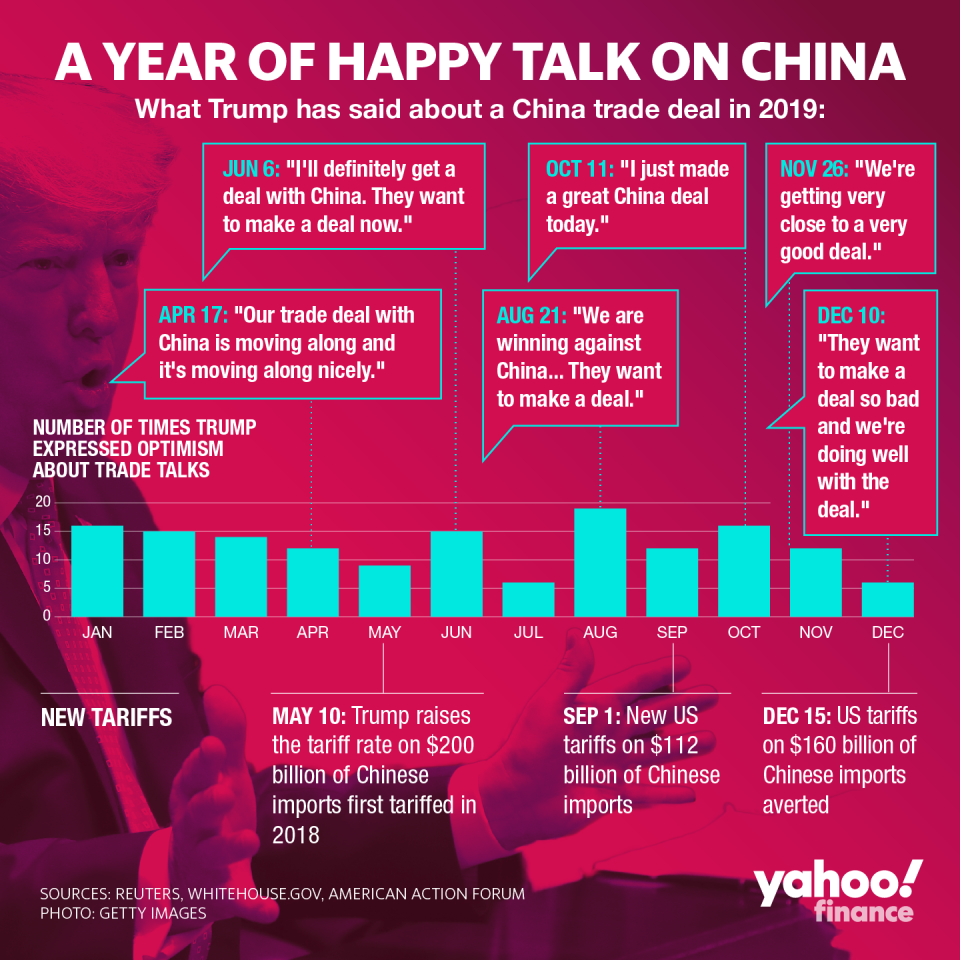
The deal was re-announced in December with more details and confirmation from the Chinese side. “The deal was finished, but the translation is very important,” said Trump on Dec. 16. A signing of the phase one deal is widely expected in the coming days.
Yahoo Finance analyzed all publicly available remarks from the president on China and tariffs throughout the year. (Trump’s comments from 2018 were not analyzed.) In calculating totals, Trump often made a statement multiple times during a single event, which was counted as a single instance.
‘Very well’ or ‘we’ll see what happens’
When Trump wasn’t touting how “well” trade talks were going, the message instead was “we’ll see what happens.”
June – when prospects for a deal seemed murky – is a good example. Things were going “well” only three times: Trump’s low for the year. Also in June, he said we’ll “see what happens” 10 times (on June 6, 6, 10, 12, 18, 18, 26, 28, 28, 29) – his high of the year.
The ambiguous language was one way for Trump to downplay the need for a deal. On June 28, ahead of a highly anticipated meeting with Chinese president Xi Jinping, Trump said “we’re a hot country, we’re doing well. So we’ll see what happens tomorrow with China.”
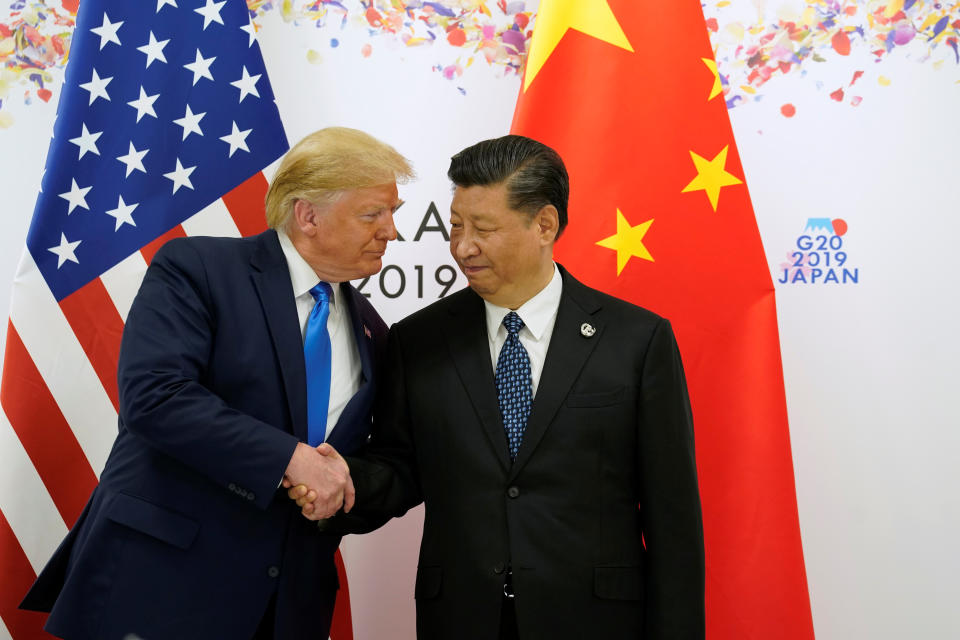
The two messages often overlapped. On June 12, Trump said, "We’re doing very well with respect to China," and "I have a feeling that we’re going to make a deal." But moments later he added, "I’d like to make a deal, but we’ll see what happens."
The vague and uninformative “we’ll see what happens” has long been a Trump favorite. In 2018, the New York Times documented his use of the phrase for a wide range of issues from Syria to China.
Over the entirety of 2019, Trump described the China negotiations as going “well” at least 92 times, while saying we’ll “see what happens” with the talks at least 73 times.
A mixed impact on the market
Trump stayed resolutely on message even during the challenging months of May-August when the chances of a deal often felt distant. The president offered some sort of optimistic sentiment nearly 40% of the time when he discussed the talks during those months.
“The deal with China is coming along very well,” he said on Oct. 21. (“If you think this headline is also from Oct 2018, you are right,” was the response from @zerohedge on Twitter.)
His words moved the markets throughout 2019 but the impact varied considerably depending on the month. Trump’s statements appeared to have had the most potency at the beginning and end of 2019.
In January and February, there was general optimism the U.S. and China were headed toward a deal and Trump used optimistic language nearly every time he discussed the issue. He spoke positively of negotiations 12 times during market hours – and the S&P 500 index closed higher on 83% of those days. The market went up on 68% of all trading days during those two months.
The pattern was similar in October, November and December. Trump was touting a phase one deal and spoke positively during 19 different market sessions (through Dec. 27). The market went up on 84% of those days. Overall, the market went up 65% of the time during that span.
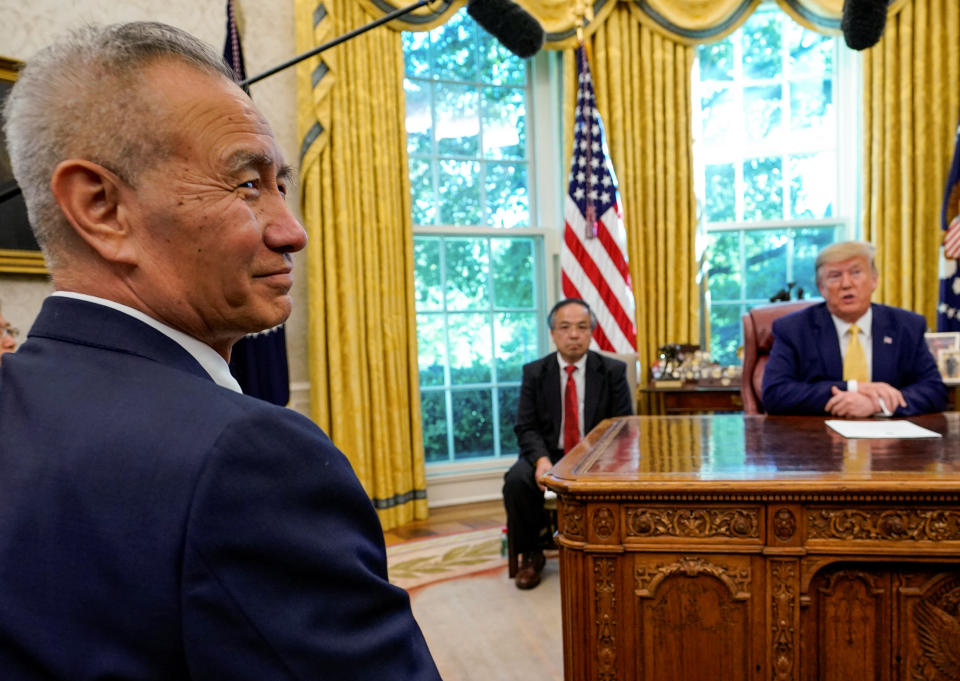
For the rest of the year, Trump’s trade statements didn’t have such a positive effect on stocks. From March to September, the market closed higher on 41% of the days Trump made rosy comments about trade. In total, stocks rose on 55% of days in that seven-month stretch.
We might remember the moments when a comment or a tweet from the president spiked the markets but the overall effect of his words appears to have only had a mild effect. The president used optimistic language during 60 market sessions in 2019 (through December 27). The market rose on about 63% of those days. For that entire 11-month stretch (250 trading days), the market rose about 60% of the time.
The ‘great relationship’ with Xi Jinping that may have cooled slightly
Trump has occasionally acknowledged problems with the talks. In May – days after discussions broke down in acrimony and new tariffs – the president tweeted “The Trade Deal with China continues, but too slowly, as they attempt to renegotiate. No!”
We found around 40 similar comments in the months that followed as White House aides scrambled to get the talks back on track. “I think it was necessary to go through this, you would say, ‘a rough patch,’ but I’d say maybe much more than a rough patch,” Trump said on Aug. 26.
But even during the rough patch, Trump heaped praise on his Chinese counterpart. “So China is run by, really, a great leader. I think he’s a great leader.” Trump also said on Aug. 26.
In fact, Trump’s praise of Xi Jinping was (until recently at least) was a constant feature of his remarks. He has directly referenced the Chinese president at least 101 times in 2019 in connection with the trade talks and often offered kind words.
"I think that President Xi and myself have a great relationship,” the president said on Jan. 4. Almost 11 months later, he added during a Fox New interview, “He's a friend of mine. He's an incredible guy.”
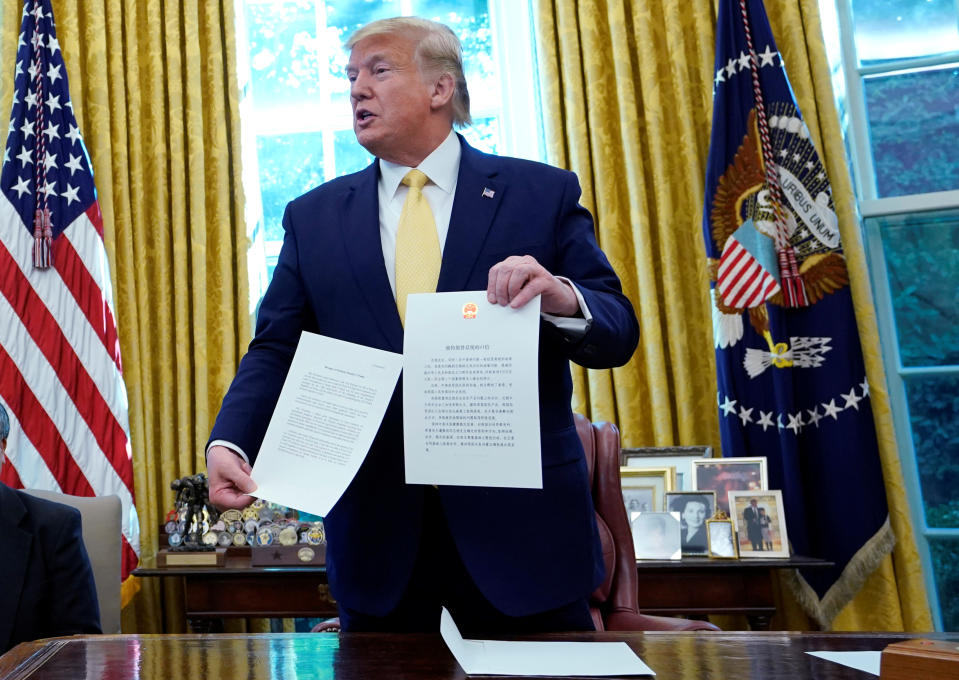
It’s a question as to whether the admiration is mutual: the Chinese side hasn’t confirmed Trump’s claims of friendship. Xi Jinping rarely mentions Trump when he speaks in public. He doesn’t have social media accounts, and only gave public speeches a handful of times in 2019. When he spoke, he focused on overall trade relations and avoided naming Trump.
In October, before the New Economy Forum organized by Bloomberg LP, Xi threw his support behind a phase one deal but added that Beijing was not afraid to retaliate when necessary and said the deal should be “on the basis of mutual respect and equality.” President Trump objected to that language.
China has used venues like state-run media to communicate with people about the progress of the year-long trade negotiations. Major mouthpieces, including People’s Daily, Global Times and broadcasting platform CCTV, have run editorials about China’s stance on the trade negotiations and attacked Peter Navarro, one of the biggest China hawks in the White House. Hu Xijing, the editor-in-chief of Global Times, has become widely followed by traders on Twitter for providing insider information into Beijing’s thinking in the trade negotiations.
Interestingly, Trump’s mentions of Xi have fallen off as 2019 comes to a close. We found just four mentions of Xi in November and three in December, making them the two lowest months of the year.
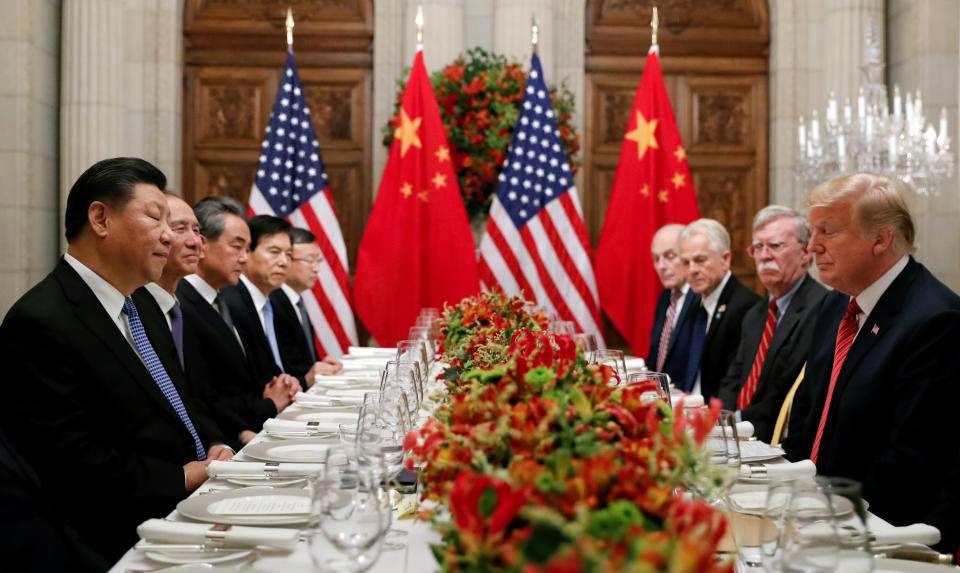
The three mentions in December featured less of the usual praise. On Dec. 20, Trump tweeted that he "had a very good talk with President Xi of China concerning our giant Trade Deal." He mentioned the same call in a speech two days later but focused on the issue of Fentanyl. The president recounted that "I said you got to do that: fentanyl coming out of China." On Christmas Eve, Trump was unclear with reporters about whether he and Xi would sign the agreement or whether it would be done by aides: We’ll have a quicker signing, because we want to get it done," he said.
Previously, U.S. Trade Representative Robert Lighthizer had told reporters that the signing of the deal would not be done by Trump and Xi but would be signed by himself and his Chinese counterpart.
On Nov. 12, Trump joked during a speech at the Economic Club of New York that Xi “was not as imposing a figure as [White House economic adviser] Larry Kudlow, but he was quite imposing.”
On to ‘phase two’
As observers look to 2020, Trump has repeatedly signaled – 10 times in the last three months – that he’s looking toward a phase two deal when he gets phase one wrapped up. “This is phase one of an either phase two or phase three deal,” said the president on Oct. 11.
Trump also signaled that his proclivity for tariffs (and the market uncertainty they bring) will remain in 2020.
Many tariffs will likely remain in effect even after a phase one deal is signed and the president recently noted, “we’ll use them for future negotiations on the phase two deal.”
Ben Werschkul is a producer for Yahoo Finance in Washington, DC. Sarah Paynter, Krystal Hu, and Jared Blikre contributed additional reporting.
Read more:
Trump made this false claim about China and tariffs at least 108 times in 2019
Why you can’t believe anything Trump says on China
Trump’s China deal won’t win many voters
Read the latest financial and business news from Yahoo Finance
Follow Yahoo Finance on Twitter, Facebook, Instagram, Flipboard, LinkedIn, YouTube, and reddit.
